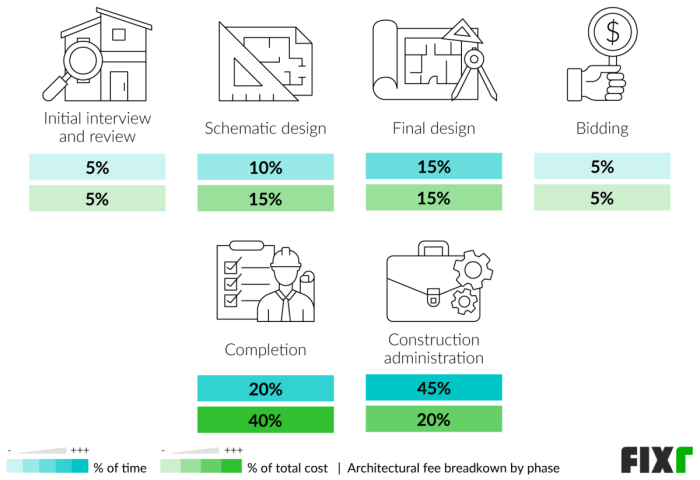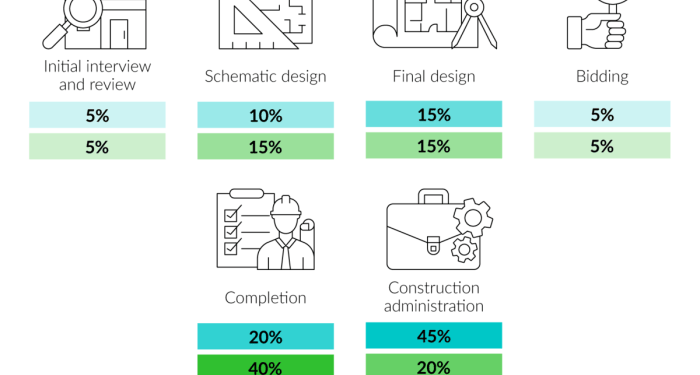Embarking on a journey through the intricacies of Architectural design services cost breakdown, we delve into a world where creativity meets financial prudence. This exploration promises to shed light on the often overlooked but crucial aspect of budgeting in architectural endeavors.
As we navigate through the different facets of cost breakdowns in architectural design services, a clearer picture emerges of the financial landscape that architects and designers must navigate with precision.
Overview of Architectural Design Services Cost Breakdown

Architectural design services encompass the planning, designing, and coordination involved in creating a structure that meets the aesthetic, functional, and safety requirements of a building project. This includes developing detailed drawings, specifications, and layouts to guide the construction process.Understanding cost breakdowns in architectural projects is crucial for clients and stakeholders to have transparency and clarity on where their money is being allocated.
It helps in setting realistic budgets, making informed decisions, and avoiding any unexpected expenses along the way.
Examples of Typical Services in Architectural Design Cost Breakdowns
- Concept Development: Initial brainstorming and idea generation to establish the design direction.
- Schematic Design: Creating rough sketches and layouts to illustrate the overall project vision.
- Design Development: Refining the initial concepts into detailed drawings, renderings, and material selections.
- Construction Documentation: Preparing precise drawings, specifications, and instructions for builders to follow accurately.
- Permitting and Approvals: Handling the necessary paperwork, permits, and approvals from local authorities for project legality.
- Project Management: Overseeing the construction process, coordinating with contractors, and ensuring the project stays on track.
Factors Influencing Architectural Design Services Costs
When it comes to architectural design services, several factors can significantly influence the cost breakdown. Understanding these factors can help clients make informed decisions and budget effectively for their projects.
Project Size
The size of a project plays a crucial role in determining the overall cost of architectural design services. Larger projects typically require more time, resources, and manpower, leading to higher costs. Smaller projects, on the other hand, may be more budget-friendly due to their reduced scale.
Project Complexity
The complexity of a project, including intricate design elements, unique structural requirements, or challenging site conditions, can impact the cost of architectural design services. Projects that demand specialized expertise or innovative solutions may incur higher expenses.
Location
The geographical location of a project can also influence architectural design costs. Projects in urban areas with higher living standards and construction costs may be more expensive than those in rural areas. Local building regulations and permit fees can also vary, affecting overall expenses.
Scope of Work
The scope of work defined for a project can impact architectural design costs. Projects with extensive requirements, such as multiple buildings, interior design services, or landscaping design, may be more costly compared to simpler projects with limited scope.
Material Selection
The choice of materials used in architectural design can have a significant impact on costs. High-end materials, imported finishes, or sustainable options may increase expenses, while cost-effective alternatives can help reduce overall project expenditures.
Technology Integration
Integrating advanced technologies, such as Building Information Modeling (BIM) or smart building systems, can enhance project efficiency and functionality but may also add to architectural design costs. The level of technology integration required can influence pricing accordingly.
Sustainability Requirements
Increasing emphasis on sustainability and green building practices has led to additional costs in architectural design services. Implementing energy-efficient solutions, eco-friendly materials, and green building certifications can contribute to higher project expenses but offer long-term benefits in terms of environmental impact and operational savings.
Detailed Cost Components in Architectural Design Services
When it comes to architectural design services, there are several cost components that contribute to the overall project budget
Breakdown of Cost Components
- Design Fees: This includes the fees charged by the architectural firm for their design services, which can vary depending on the scope and complexity of the project.
- Construction Costs: These costs cover the actual construction of the project, including materials, labor, and equipment.
- Permits and Approvals: Obtaining permits and approvals from relevant authorities is a crucial part of any architectural project and comes with associated costs.
- Consultant Fees: Architectural projects often require input from various consultants, such as structural engineers, HVAC specialists, and interior designers, each with their own fees.
- Site Preparation: Costs related to site preparation, such as clearing, grading, and utility connections, are also included in the overall budget.
Percentage Distribution of Costs
| Cost Component | Percentage Distribution |
|---|---|
| Design Fees | 10-20% |
| Construction Costs | 60-70% |
| Permits and Approvals | 5-10% |
| Consultant Fees | 5-15% |
| Site Preparation | 5-10% |
Each of these cost components plays a vital role in the successful completion of an architectural project. Design fees ensure that the architectural firm can dedicate the necessary time and resources to create a well-thought-out design that meets the client's requirements.
Construction costs cover the actual realization of the design, including materials, labor, and equipment. Permits and approvals are essential for legal compliance and ensuring that the project can move forward without any issues. Consultant fees bring in specialized expertise to address specific aspects of the project.
Finally, site preparation costs are necessary to ensure that the project site is ready for construction activities to commence smoothly. By understanding these cost components and their contribution to the overall project budget, clients can make informed decisions and better manage their expectations throughout the architectural design process.
Cost Estimation Methods and Tools in Architectural Design
Cost estimation is a crucial aspect of architectural design projects as it allows for effective project planning and budget management. Utilizing various methods and tools can help architects and designers accurately predict the costs involved in a project.
Methods of Cost Estimation
- Expert Judgment: Architects rely on their expertise and experience to estimate costs based on similar past projects.
- Parametric Estimating: This method uses statistical relationships and parameters to predict costs based on project characteristics.
- Analogous Estimating: Cost estimates are made by comparing the current project with previous similar projects.
Importance of Accurate Cost Estimation
Accurate cost estimation is essential for project planning as it helps in setting realistic budgets, managing resources effectively, and avoiding cost overruns. It enables clients to make informed decisions and ensures that the project stays within the allocated budget.
Cost Estimation Tools
- Building Information Modeling (BIM): BIM software enables architects to create detailed 3D models that can be used for accurate cost estimation.
- Cost Estimating Software: Tools like RSMeans and CostX provide architects with databases of material and labor costs for more precise estimates.
- Spreadsheets: Architects often use Excel or similar spreadsheet software to create detailed cost breakdowns and analyze project expenses.
Epilogue

In conclusion, the discussion of Architectural design services cost breakdown unveils a realm where artistry and economics converge. By understanding the financial intricacies of design projects, professionals can ensure not only creative excellence but also fiscal responsibility in their endeavors.
Popular Questions
What does architectural design services entail?
Architectural design services encompass everything from initial concept creation to final construction oversight, ensuring a cohesive and functional design.
How do project size and complexity affect pricing?
Generally, larger and more complex projects require more resources and expertise, leading to higher costs in architectural design services.
What are some common cost estimation tools used by architects?
Architects often utilize software like Revit, AutoCAD, and SketchUp for accurate cost estimations in design projects.













